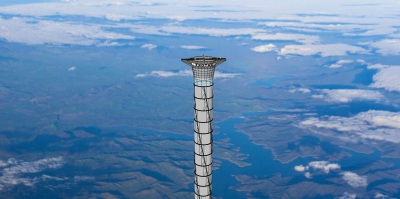GOING UP...IN A SPACE ELEVATOR
/
Photo from thothx.com
A Canadian company has just received a US patent for a new invention. It made headlines because it’s big news. Big, as in, twenty kilometres tall. Thoth Technology of Pembroke, Ontario has designs to build a free-standing tower to the sky, not to touch the face of God, but to house a space elevator.
The reason for a space elevator is to remove the need for expensive and wasteful rockets to reach Earth orbit and, from there, the rest of outer space. The usual concept, as promoted by science fiction master Arthur C. Clarke and others, is to have a large terminus in a geo-stationary orbit (travelling at the same speed as the spin of the Earth so it remains over the same spot on the planet’s surface). From the terminus a cable would be lowered until it reached the ground (like Jack’s beanstalk in reverse). Then cargo and passengers would travel up and down the cable by magnetic or other means. That’s the plan put forward by the Japanese Obayashi Corporation in an announcement last year. They hope to build such an elevator by 2050. The biggest challenge to overcome is the cable, especially since their plans include extending the cable beyond geosynchronous orbit to a counterweight about a quarter of the way to the Moon. You probably can’t imagine the weight of a cable 96,000 kms long. I can’t either. In nanofibres made of Carbon 60 they might have a material with the strength to handle the load at a manageable weight, but so far such fibres have only been made in lengths of a few centimetres. Technology has some catching up to do.
The Thoth Technology plan is very different. Their scheme would involve building a twenty-kilometer-tall tower out of giant inflatable modules stacked on top of one another. Computers would control the inflation of individual gas cells within the modules to keep the whole thing balanced. In the face of a wind, for example, they would presumably increase the inflation on the leeward side and lean the tower into the wind. On top of the tower would be a runway from which space planes could take off and land. This would remove the need for the initial vertical portion of most rocket flights which uses up a third of their fuel.
That’s the advantage. The disadvantages?
Well, remember the last time you went to the airport to catch a flight? Now imagine all that plus a twenty kilometre elevator ride, after which you still wouldn’t be in space —you’d still have to catch a plane. Your luggage would just have twenty extra kilometres in which to get lost.
I imagine they’d be required to build it at least twenty kilometres from any inhabited area, just in case it ever did fall over. Not to mention fools dropping quarters from the observation deck.
And I keep trying to picture a pilot attempting a take-off from something like a gigantic version of one of those bouncing inflatable amusement rides for kiddies.
Personally, I think the original space elevator concept is more workable, in spite of the engineering challenges. But I’ve been wrong before. In any case, Thoth Technologies estimates it could cost five to ten billion US dollars to build their tower. That may be a little rich for Kickstarter. Possibly for Richard Branson, and even Elon Musk, too. On the other hand, if the current Canadian government loses the upcoming election, their successors would probably cancel plans to spend $29 billion on F35 fighter jets. Just sayin’.
They might even be able to subsidize some of the tower’s cost by incorporating a department store:
“Going up! Next floor: space toys, mining equipment, and women’s lingerie…” (A little flash of Sandra Bullock in Gravity there.)

